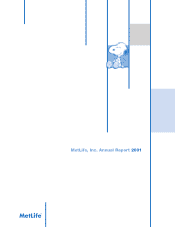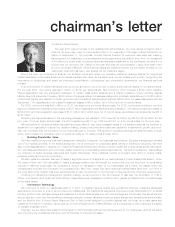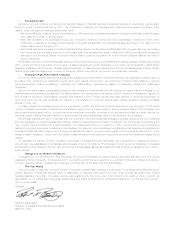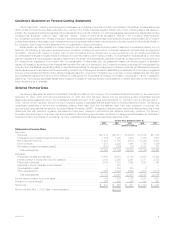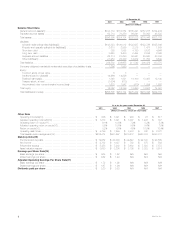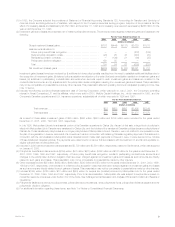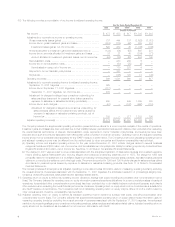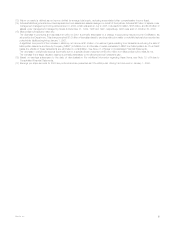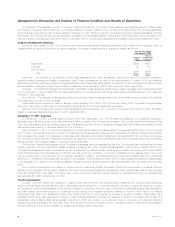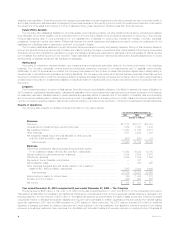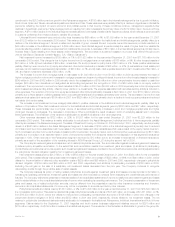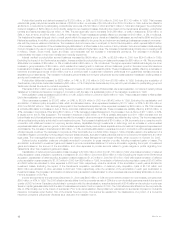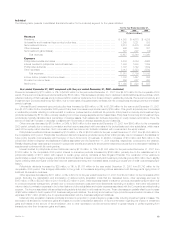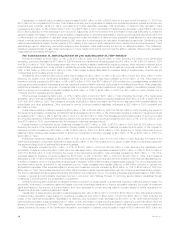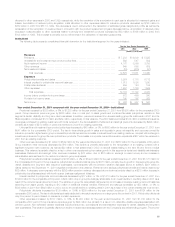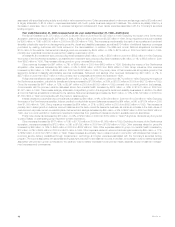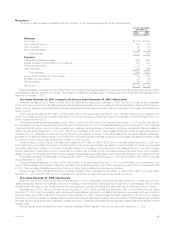MetLife 2001 Annual Report Download - page 11
Download and view the complete annual report
Please find page 11 of the 2001 MetLife annual report below. You can navigate through the pages in the report by either clicking on the pages listed below, or by using the keyword search tool below to find specific information within the annual report.
variables, such as inflation. These factors enter into management’s estimates of gross margins and profits which generally are used to amortize certain of
such costs. Revisions to estimates result in changes to the amounts expensed in the reporting period in which the revisions are made and could result in
the impairment of the asset and a charge to income if estimated future gross margins and profits are less than amounts deferred.
Future Policy Benefits
The Company also establishes liabilities for amounts payable under insurance policies, including traditional life insurance, annuities and disabled
lives. Generally, amounts are payable over an extended period of time and the profitability of the products is dependent on the pricing of the products.
Principal assumptions used in pricing policies and in the establishment of liabilities for future policy benefits are mortality, morbidity, expenses,
persistency, investment returns and inflation. Differences between the actual experience and assumptions used in pricing the policies and in the
establishment of liabilities result in variances in profit and could result in losses.
The Company establishes liabilities for unpaid claims and claims expenses for property and casualty insurance. Pricing of this insurance takes into
account the expected frequency and severity of losses, the costs of providing coverage, competitive factors, characteristics of the property covered and
the insured, and profit considerations. Liabilities for property and casualty insurance are dependent on estimates of amounts payable for claims reported
but not settled and claims incurred but not reported. These estimates are influenced by historical experience and actuarial assumptions of current
developments, anticipated trends and risk management strategies.
Reinsurance
Accounting for reinsurance requires extensive use of assumptions and estimates, particularly related to the future performance of the underlying
business. The Company periodically reviews actual and anticipated experience compared to the assumptions used to establish policy benefits.
Additionally, for each of its reinsurance contracts, the Company must determine if the contract provides indemnification against loss or liability relating to
insurance risk, in accordance with applicable accounting standards. The Company must review all contractual features, particularly those that may limit
the amount of insurance risk to which the Company is subject or features that delay the timely reimbursement of claims. If the Company determines that a
contract does not expose it to a reasonable possibility of a significant loss from insurance risk, the Company records the contract on a deposit method of
accounting.
Litigation
The Company is a party to a number of legal actions. Given the inherent unpredictability of litigation, it is difficult to estimate the impact of litigation on
the Company’s consolidated financial position. Liabilities are established when it is probable that a loss has been incurred and the amount of the loss can
be reasonably estimated. Liabilities related to certain lawsuits are especially difficult to estimate due to the limitation of available data and uncertainty
around numerous variables used to determine amounts recorded. It is possible that an adverse outcome in certain cases could have an adverse effect
upon the Company’s operating results or cash flows in particular quarterly or annual periods. See Note 11 of Notes to Consolidated Financial Statements.
Results of Operations
The following table presents consolidated financial information for the years indicated:
For the Year Ended December 31,
2001 2000 1999
(Dollars in millions)
Revenues
Premiums*********************************************************************** $17,212 $16,317 $12,088
Universal life and investment-type product policy fees ********************************** 1,889 1,820 1,433
Net investment income *********************************************************** 11,923 11,768 9,816
Other revenues ****************************************************************** 1,507 2,229 1,861
Net investment losses (net of amounts allocable to other accounts
of $(134), $(54) and $(67), respectively) ******************************************* (603) (390) (70)
Total revenues *************************************************************** 31,928 31,744 25,128
Expenses
Policyholder benefits and claims (excludes amounts directly related
to net investment losses of $(159), $41 and $(21), respectively) *********************** 18,454 16,893 13,100
Interest credited to policyholder account balances ************************************* 3,084 2,935 2,441
Policyholder dividends ************************************************************ 2,086 1,919 1,690
Payments to former Canadian policyholders ****************************************** — 327 —
Demutualization costs************************************************************* — 230 260
Other expenses (excludes amounts directly related to net investment
losses of $25, $(95) and $(46), respectively) *************************************** 7,565 8,024 6,462
Total expenses ************************************************************** 31,189 30,328 23,953
Income before provision for income taxes ******************************************** 739 1,416 1,175
Provision for income taxes********************************************************* 266 463 558
Net income ********************************************************************* $ 473 $ 953 $ 617
Year ended December 31, 2001 compared with year ended December 31, 2000 — The Company
Premiums grew by $895 million, or 5%, to $17,212 million for the year ended December 31, 2001 from $16,317 for the comparable 2000 period.
This variance is attributable to increases in the Institutional, Reinsurance, International and Auto & Home segments, partially offset by a decrease in the
Individual segment. An improvement of $388 million in the Institutional segment is predominately the result of sales growth and continued favorable
policyholder retention in this segment’s dental, disability and long-term care businesses. In addition, significant premiums received from several existing
group life customers in 2001 and the BMA acquisition in 2000 resulted in higher premiums. The 2000 balance includes $124 million in additional
insurance coverages purchased by existing customers with funds received in the demutualization and significant premiums received from existing
retirement and savings customers. New premiums from facultative and automatic treaties and renewal premiums on existing blocks of business all
MetLife, Inc.
8

